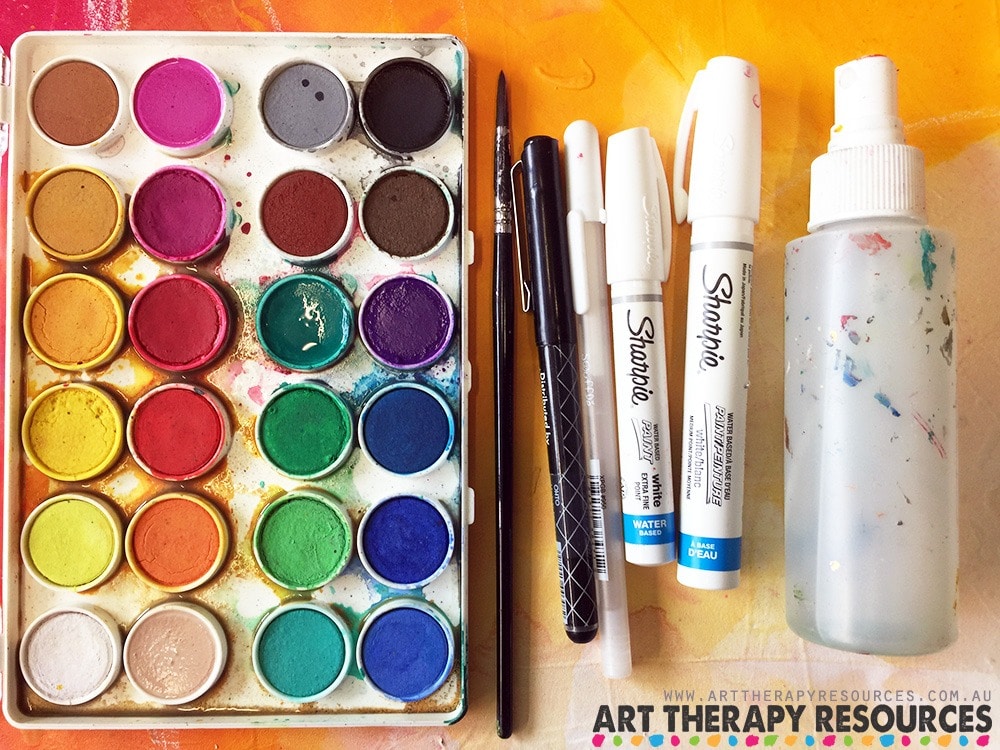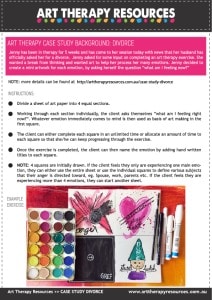THIS POST INCLUDES:
- Art Therapy and Divorce
- About the Client
- Current Client Issues
- Art Therapy Exercise
- Client Insight and Outcomes
- Disclaimer
- FREE DOWNLOAD Art Therapy Exercise
ART THERAPY AND DIVORCE
As a client goes through the experience of a divorce, they will be confronted with various stages of emotional experience including denial, anger, grief, regret, and guilt. Art Therapy can help a client process these emotions that occur in the initial stages. With therapy, the client can work towards acceptance and resolution in order to move on to a new phase in life. This case study details the issues experienced by someone going through divorce, along with a suggested art therapy exercise. This case study details the issues experienced by someone going through divorce, along with a suggested art therapy exercise.
ABOUT THE CLIENT
- Name: Jenny
- Gender: Female
- Age: 38
- Summary of sessions to date: Jenny has been separated from her partner, John for 12 months. Jenny has been in therapy for 5 weeks and has come to her session today with news that John has officially asked her for a divorce.
CURRENT CLIENT ISSUES
Jenny had been feeling confident that she was dealing with her marriage breakdown, however this divorce request from John has brought many old emotions to the surface and she is feeling that now she has failed in both her marriage and her ability to deal with her emotions. She was expecting this day would come, however she thought she would be able to cope better than she has. She received the news 4 days ago and has not slept very much and has been ruminating on her inability to copy with her emotions.
ART THERAPY EXERCISE
Jenny asked for some input on completing an art therapy exercise. She felt exhausted from over thinking and felt that more talking would result in her simply repeating the same negative thought patterns. She wanted a break from thinking and wanted to do something with art to help her process her many emotions.
Through discussion with her art therapist, Jenny decided she wanted to try to label the many emotions she was feeling and create a mini artwork for each emotion, by asking herself the question “what am I feeling now?”.
INSTRUCTIONS:
Divide a sheet of art paper into 4 equal sections. Working through each section individually, the client asks themselves “what am I feeling right now?”. Whatever emotion immediately comes to mind is then used as the basis of art making in the first square. The client can either complete each square in an unlimited time or allocate an amount of time to each square so that she/he can keep progressing through the exercise.
Once the exercise is completed, the client can then name the emotion by adding hand written titles to each square.
NOTE: 4 squares are initially drawn. If the client feels they only are experiencing one main emotion, they can either use the entire sheet or use the individual squares to define various subjects that their anger is directed toward, eg. Spouse, work, parents etc. If the client feels they are experiencing more than 4 emotions, they can start another sheet.
SUPPLIES USED INCLUDE:

- Angora Watercolour Pan Set http://amzn.to/2hLxtf1
- White Sharpie Paint Pen X-Fine http://amzn.to/2hCZcSZ
- White Sharpie Paint Pen Medium http://amzn.to/2j36ChW
- White Jelly Roll Pen http://amzn.to/2jIhD9G
- Black Fude Ball Pen http://amzn.to/2k9pjhB
- Simply Simmons Brushes http://amzn.to/2hramK7
- XL Watercolour Pad (trimmed to 12×12 inch) http://amzn.to/2gGdja2
- Water Bottle
CLIENT INSIGHT AND OUTCOMES
Jenny felt by labeling each emotion individually in her art work, she was able to clarify her feelings. With the focus on each emotion, Jenny felt like she was able to unravel the chaos and interrupt her rumination.
Jenny felt that the exercise gave her a sense of understanding what emotions she was feeling. Jenny felt without this understanding, she was unable to interrupt her negative thought patterns. One she was able to label her feelings, she was able to start making sense of her reaction.
After completing the exercise Jenny felt empowered that she had a technique available to her that would enable her to interrupt her rumination and be proactive about dealing with her emotions in any situation.

DISCLAIMER
This case study represents a snapshot of the client’s progress in treatment. The exercise in this article could be used as written or as a guide for new and original tasks developed by the Art Therapist. Responsibility for treatment resides with the individual therapist who understands their clients specific needs. The art therapy exercise should not be viewed as a pre-defined directive on how to treat a client that presents with a specific range of problems.This art therapy exercise will help build a database of knowledge to draw upon when helping your client. Art Therapy is associated with psychotherapy techniques, however each therapist often approaches therapy with their own foundation of psychological interventions, whether it be psychotherapy, CBT, DBT or other methods.
FREE DOWNLOAD: Art Therapy Exercise
Download the FREE Art Therapy Exercise based on the above Case Study. The free download includes instructions for the art therapy exercise, along with access to a timelapse video showing an example of the art therapy exercise.

BUILD YOUR ART THERAPY REFERENCE MATERIALS:
Pin this image to your Pinterest board.

SHARE KNOWLEDGE & PASS IT ON:
If you’ve enjoyed this post, please share it on Facebook, Twitter, Pinterest. Thank you!
